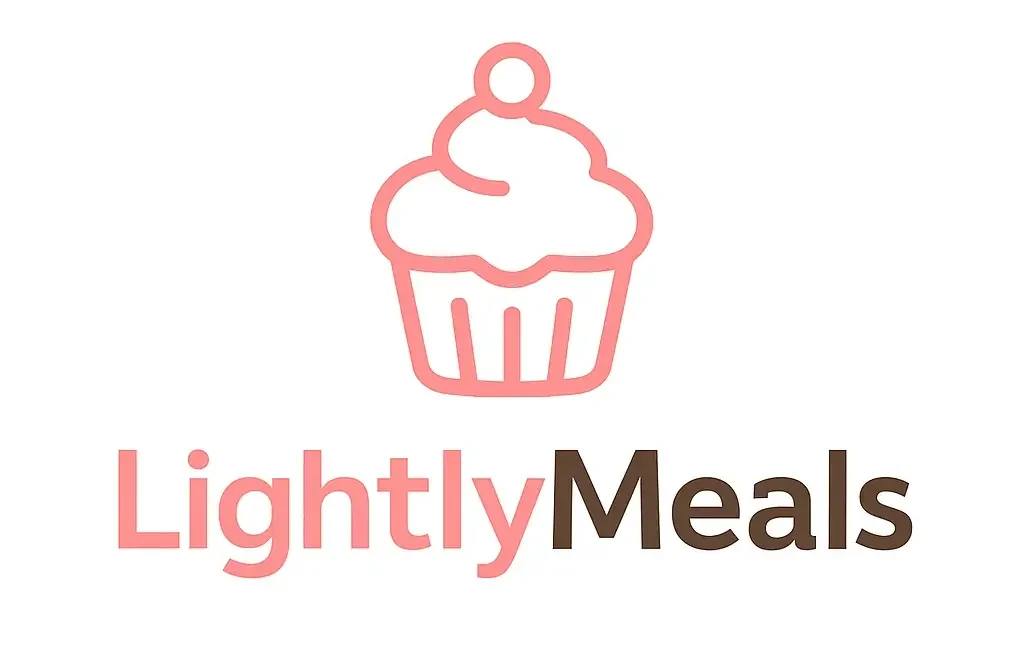Matcha green tea boba has taken the drink scene by storm—and with good reason. It blends the earthy, rich flavor of matcha with the chewy delight of tapioca pearls, creating a creamy, caffeinated treat you can’t put down. Whether you’re a longtime bubble tea lover or just starting to explore the world of matcha, this article walks you through the taste, health perks, best boba pairings, and caffeine facts. Plus, I’ll share my own journey with this vibrant drink and how you can make it perfectly at home. Ready to sip something special? Let’s dive in.
Table of Contents
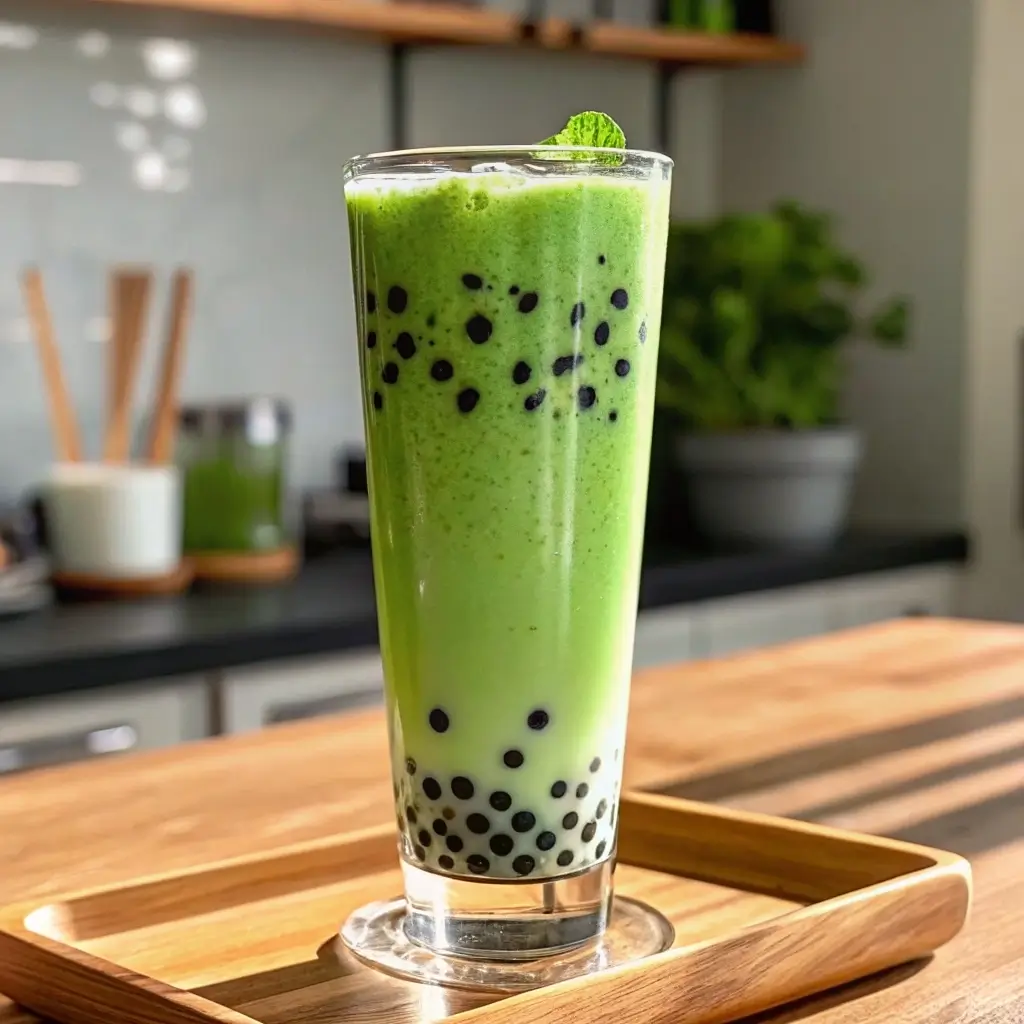
Discovering Matcha Green Tea Boba
From Kitchen Experiments to a Boba Obsession
Let me tell you—matcha green tea boba wasn’t always in my kitchen lineup. Back when my boys were little, green tea anything would’ve made them run for the hills. But one summer afternoon, armed with a can of matcha powder and the stubborn determination only a mom of twins can muster, I decided to give it a shot. The goal? Create something they’d not only sip but actually enjoy.
I started simple—just matcha, honey, and almond milk over ice. No pearls yet. But the deep, creamy flavor was surprisingly mellow, and when I finally introduced those chewy tapioca pearls… it was game over. My picky eaters were suddenly asking for “that green drink with the fun balls.” I knew we’d struck boba gold.
Since then, matcha green tea boba has become our go-to afternoon refreshment. It’s creamy, lightly sweet, and endlessly customizable. More than a drink, it became a shared ritual—something I could make in five minutes that felt like a treat, without the guilt of sugary sodas.
From our first sticky tapioca mishap to perfecting the milk-to-matcha ratio, our boba story has been full of laughs and love—just like all the best kitchen memories.
What Is Matcha Green Tea Boba, Exactly?
At its core, matcha green tea boba is a layered iced drink made with finely ground green tea powder (matcha), sweetener, milk (or dairy-free alternatives), and chewy tapioca pearls. It originated from the broader world of Taiwanese bubble tea but stands out with its signature vibrant green color and earthy, umami flavor.
Matcha, unlike steeped green tea, uses the whole leaf ground into powder, delivering a richer taste and more nutrients. The tapioca pearls—usually boiled and soaked in brown sugar syrup—bring a fun, chewy contrast to the smoothness of the tea.
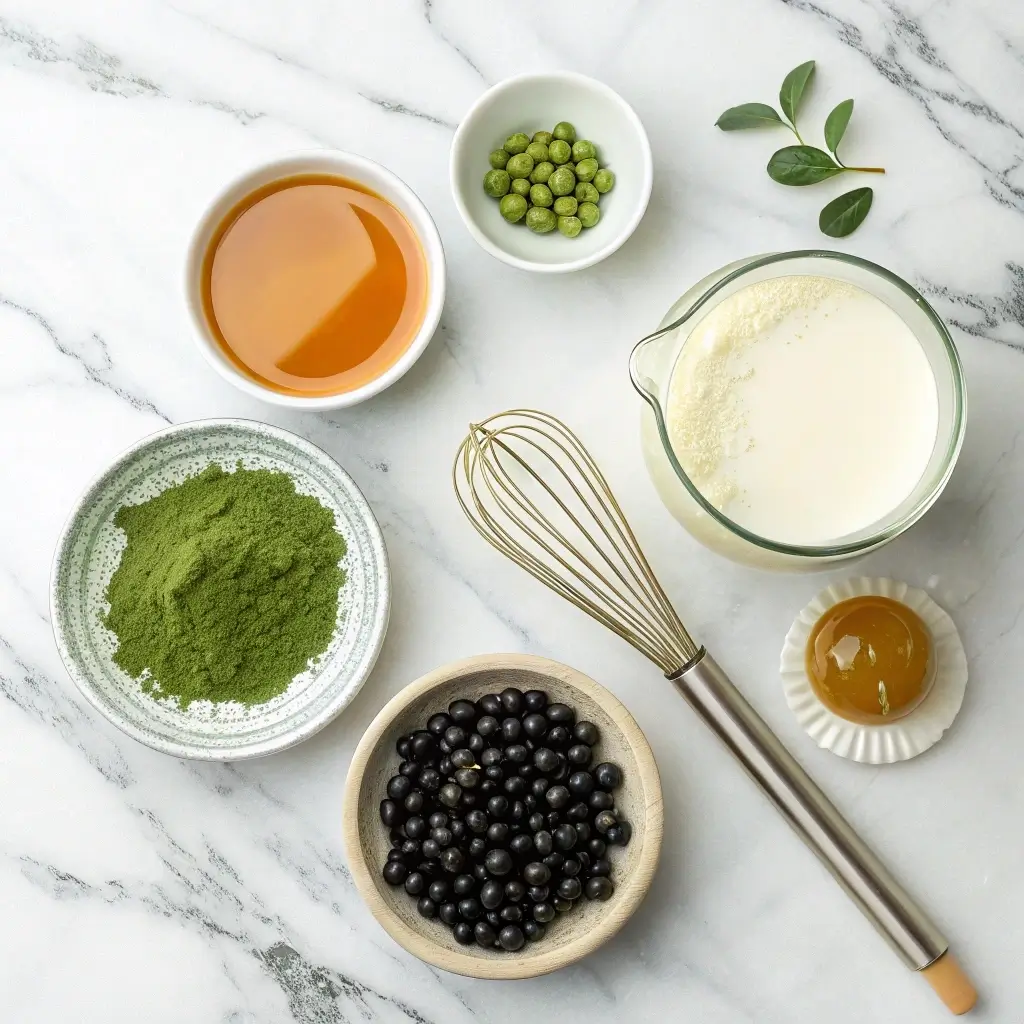
Some versions include add-ons like vanilla cream foam, oat milk, or homemade syrups. You can even tweak the texture and flavor using ingredients like almond milk for a nutty twist or coconut milk for tropical depth.
For other naturally vibrant drinks, check out my pickle lemonade recipe or this natural Mounjaro drink with 4 ingredients—both great summer refreshers like boba.
Flavor, Texture & Pairings
What Does Matcha Green Tea Boba Taste Like?
One sip of matcha green tea boba and you’re met with a bold, earthy richness that’s surprisingly smooth. Matcha has this slightly grassy, vegetal flavor—it’s not bitter like over-steeped green tea, but deep and nutty with a touch of natural sweetness. When blended with milk and sweetener, it transforms into something creamy, balanced, and totally addictive.
The tapioca pearls introduce a whole new dimension. They’re soft, chewy, and slightly sweet—like little pops of caramel tucked into your drink. It’s this play between the cold, velvety tea and warm pearls that makes boba so satisfying.
And the beauty of matcha boba? You control the balance. Want it stronger? Add more matcha. Need it sweeter? A dash of maple syrup or brown sugar syrup does the trick. The customization is part of the fun, especially if you’re introducing it to kids or guests for the first time.
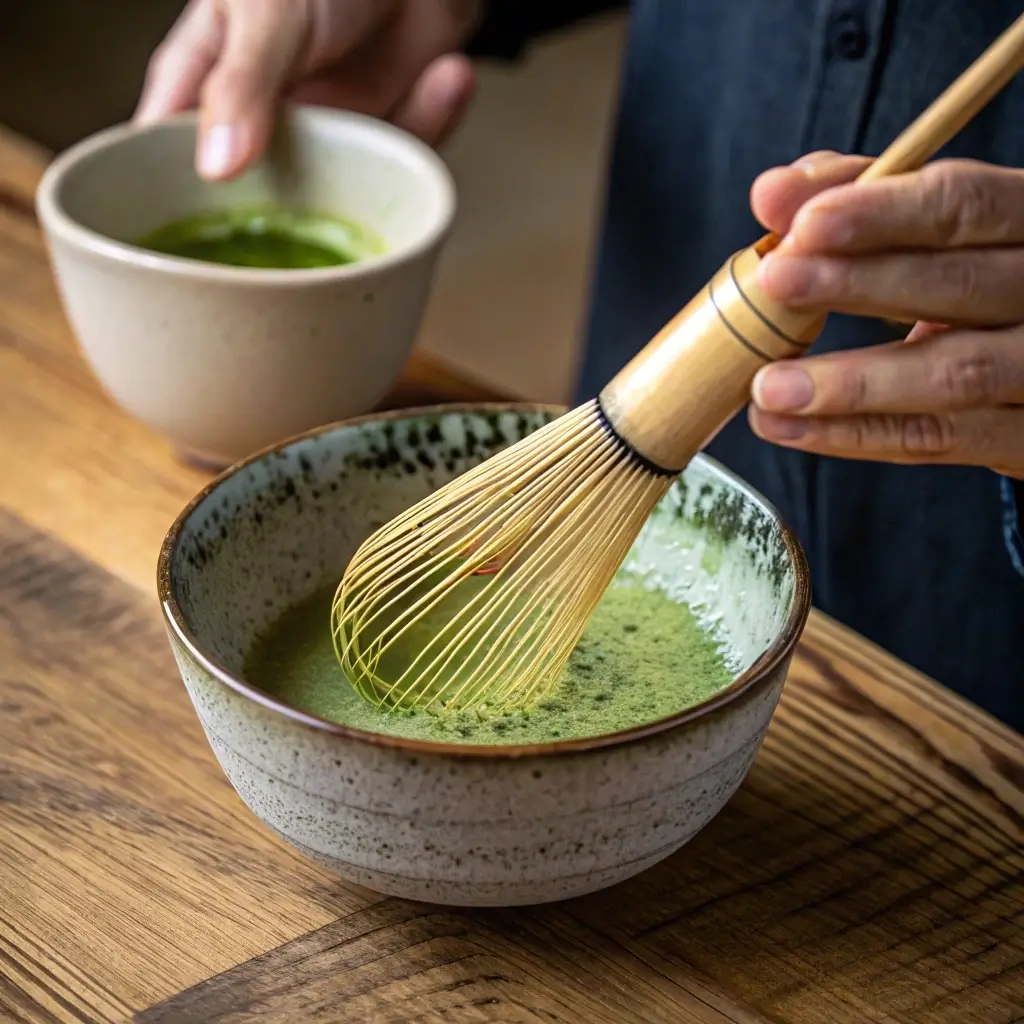
Some people even blend ice to create a matcha slushie base, making it extra frosty for summer. If you like drinks with interesting textures and a clean energy kick, this one’s for you.
Want more bold, creamy drinks to try? Don’t miss my bulletproof coffee recipe—it’s another family favorite with a rich, luxurious feel.
Which Toppings or Boba Match Best with Matcha?
While classic black tapioca pearls are the go-to for most, matcha green tea boba plays well with a wide variety of toppings. For a soft, refreshing twist, try aloe vera cubes or crystal boba—they’re lighter, jelly-like, and subtly sweet, which lets the matcha flavor shine.
If you like a sweet crunch, popping boba with fruity centers (like lychee or mango) adds bursts of flavor that brighten the drink. Brown sugar pearls are another fantastic match, especially if you love a deeper caramel taste paired with the earthy tea.
Some shops even top matcha boba with cheese foam—a sweet, salted whipped cream topping that adds a rich, creamy cap to the drink. It might sound strange, but the salty-sweet combo is magic.
At home, I usually stick to warm tapioca pearls with a drizzle of honey or homemade syrup. But my boys? They’re all about the bursting mango boba.
Want something creamy and cool with a nostalgic twist? My chocolate and vanilla ice cream recipe offers a similar comfort-with-a-twist feeling.
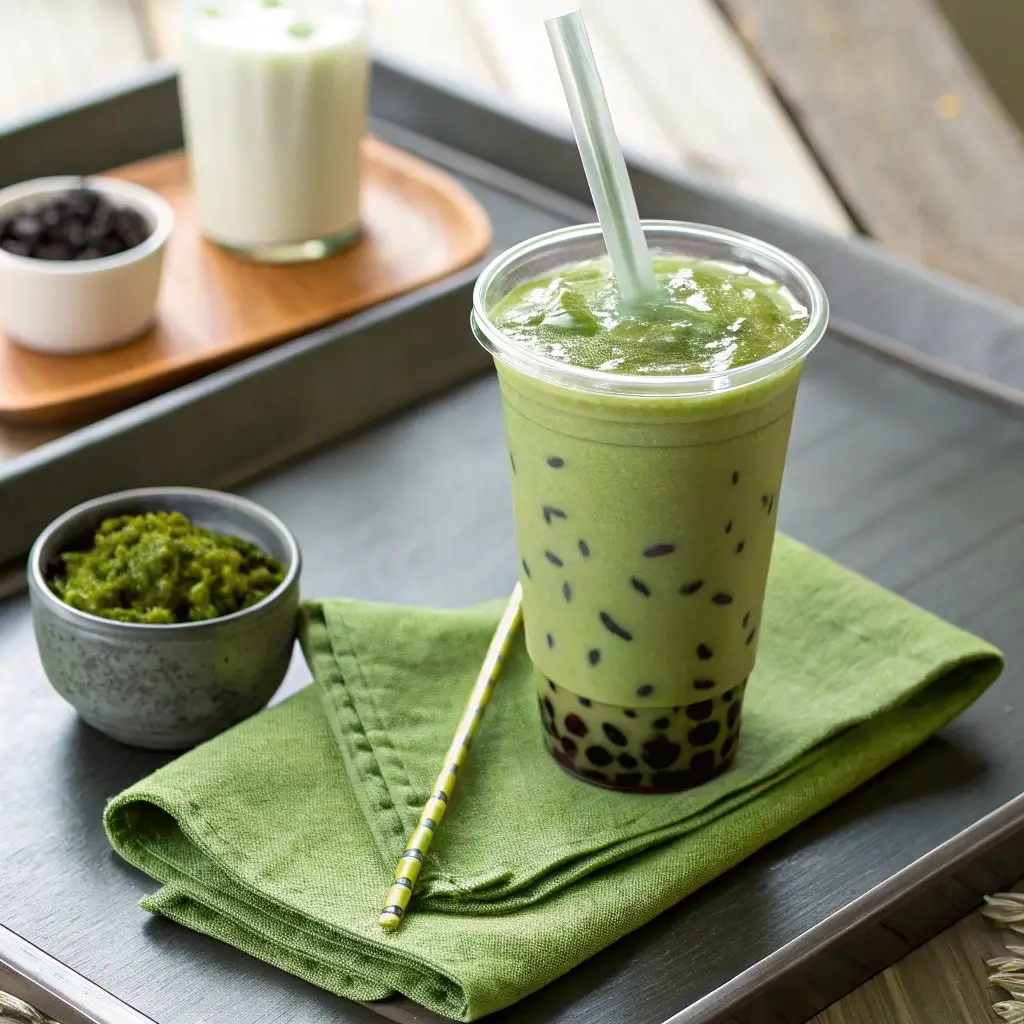
Matcha Green Tea Boba
Ingredients
Equipment
Method
- Boil tapioca pearls according to package instructions (usually 5–10 minutes), then drain and soak in a bit of honey or syrup.
- Sift the matcha powder into a bowl and whisk with hot water until frothy using a bamboo or handheld whisk.
- Add milk and sweetener to the matcha, whisking or stirring to combine well.
- Divide the cooked boba between two glasses, add ice, then pour the matcha mixture over the top.
- Stir gently and serve immediately with wide boba straws.
Nutrition
Notes
Tried this recipe?
Let us know how it was!Is Matcha Green Tea Boba Healthy?
Health Benefits of Matcha
Let’s talk matcha. This powdered green tea is more than just trendy—it’s packed with serious wellness perks. When you drink matcha green tea boba, you’re sipping a blend that’s rich in antioxidants called catechins, which are known to support heart health, reduce inflammation, and help protect cells from damage.
One standout compound is EGCG, often praised for boosting metabolism and aiding fat oxidation. Unlike regular green tea, matcha is made by whisking the entire leaf powder into the drink, giving you a more concentrated source of nutrients and chlorophyll.
But the magic doesn’t stop there. Matcha contains L-theanine, an amino acid that promotes calm focus. It helps smooth out the caffeine buzz, giving you sustained energy without the crash or jitters. It’s one of the reasons I started making this drink when my afternoons got hectic—I could stay energized and clear-headed without the post-coffee slump.
Just be mindful: while matcha itself is healthy, many café versions of matcha green tea boba come loaded with sugar, creamers, and calorie-dense toppings. That’s where making it at home becomes a total game-changer.
Need a boost from another natural drink with benefits? Try my homemade Mounjaro recipe for weight loss—also designed to keep you energized without sacrificing flavor.
How to Make It Healthier at Home
The key to a healthier matcha green tea boba starts with what you put in your cup. Swap out sugary syrups for maple syrup, honey, or monk fruit sweetener. Use unsweetened almond milk, oat milk, or light coconut milk to keep calories in check while still delivering creaminess.
For the tapioca pearls, opt for homemade versions with less added sugar, or reduce the portion size. I often cook mine in a lightly sweetened syrup, just enough to flavor without overwhelming.
Another trick? Blend in chia seeds or flax for extra fiber, or skip the boba and use fruit-based popping pearls for a lower-calorie twist.
Matcha pairs well with almost any milk, which makes it easy to customize to your taste and dietary needs. Plus, controlling ingredients at home means you can enjoy it more often—guilt-free.
For more guilt-free desserts to pair with your matcha, check out this banana split ice cream. It’s fun, fresh, and full of simple ingredients—just like a good boba recipe.
For more fun variations and ideas, check out our Facebook and Pinterset sections where creativity meets craving.
Matcha & Caffeine Facts
Does Matcha Boba Have Caffeine?
Yes, matcha green tea boba contains caffeine—but in a gentler, more balanced form than your usual coffee. One cup of matcha can deliver around 70 milligrams of caffeine, depending on the quality and amount of powder used. But thanks to its amino acid L-theanine, the caffeine from matcha is released slowly, giving you steady energy without the crash.
This is one reason matcha green tea boba is such a great option for afternoon sipping. Unlike coffee, which can spike your energy and then leave you drained, matcha keeps you calmly alert for hours. It’s my go-to drink when I’m juggling blog drafts, recipe testing, or even running errands. It energizes me without making me feel wired.
If you’re sensitive to caffeine, don’t worry—just adjust the amount of matcha powder in your drink. You can also try decaf variations by blending less matcha with almond or oat milk. But if you’re looking for that clean, focused lift, matcha green tea boba truly delivers.
Explore another better-for-you energy drink in my sugar-free coffee creamer—it’s perfect for pairing with a matcha-based morning routine.

When’s the Best Time to Drink It?
For the best results, enjoy matcha green tea boba mid-morning to mid-afternoon. That timing gives your body the energy boost it needs while keeping your sleep rhythm in check. I usually sip mine between 1 and 3 p.m.—especially on sunny Santa Barbara days when a cold, creamy cup is all I crave.
Drinking matcha green tea boba after a balanced meal can also help with digestion and give your metabolism a gentle push, thanks to its antioxidants.
Matcha green tea boba isn’t just a drink—it’s a smart, delicious ritual you can build your day around.
Looking for more dreamy, rich treats to go with it? Try my homemade chocolate ice cream recipe—cool, velvety, and a perfect matcha companion.
FAQs About Matcha Green Tea Boba
What does matcha green tea boba taste like?
Matcha green tea boba tastes creamy, earthy, and slightly sweet. The matcha adds a bold, grassy depth, while milk and sweeteners round it out. The tapioca pearls bring a chewy, caramel-like finish, making it both refreshing and indulgent.
Is matcha green tea boba healthy?
Yes, when made mindfully. Matcha is full of antioxidants, supports metabolism, and provides clean energy. To keep your matcha green tea boba healthy, use natural sweeteners, dairy-free milk, and reduce sugar in the boba pearls.
What boba goes well with matcha?
Matcha pairs well with black tapioca pearls, brown sugar pearls, or lighter toppings like aloe vera, popping boba, and crystal jelly. These toppings complement the earthy matcha flavor without overpowering it.
Does matcha boba tea have caffeine?
Yes, matcha green tea boba contains caffeine—usually around 70 mg per cup. However, it also includes L-theanine, which provides a smoother, more focused energy without the crash typically associated with coffee.
what does matcha boba tea taste like ?
Matcha boba tea has a unique, layered flavor profile that blends the earthy, slightly bitter taste of matcha green tea with the creamy sweetness of milk. The matcha itself brings a grassy, umami-rich depth, which is well-balanced by the creamy base—often made with dairy or plant-based milk like oat, almond, or coconut. The boba pearls (tapioca balls) add a chewy texture and a touch of brown sugar or honey sweetness, creating contrast with the matcha’s natural boldness.
Conclusion
From its vibrant color to its smooth, energizing taste, matcha green tea boba is more than just a trendy drink—it’s a crave-worthy ritual. Whether you’re trying to switch up your caffeine routine, cut back on sugary drinks, or just enjoy something a little special, this drink delivers. And the best part? You can customize it at home to be as rich, creamy, or light as you like.
If you haven’t made matcha green tea boba yet, now’s your chance. All you need is good matcha, a touch of milk, and some chewy boba to transform your day.
